| |  |
 More
on Weed management>> More
on Weed management>> |
| | | Disease management |
Tea like other agricultural crop is prone to attack by many diseases
and some of which cause serious losses. Most of the tea diseases are of fungal origin and only a few are caused by bacteria, viruses and algae. The crop loss due to diseases vary between 10 and 15% and mainly depends on pathogen
and the geography of the area. The important diseases of tea can be categorised as leaf, stem and root diseases. |
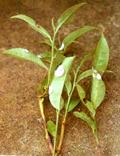 |
Leaf diseases
Blister blight caused by the fungus Exobasidium vexans Massee. It can only infect young and succulent leaves and stems of nursery, mature tea and teas recovering from pruning. It does not affect the mature leaves or stem. The disease is first evident as pale yellow translucent spots on the first three young leaves within three to ten days after infection. The translucent spot gradually enlarge in size and seven to nine days later these spots become shiny, concave
on the upper surface and white or pink powdery and convex on the underside where the spores are borne. After sporulation the blisters turn brown and dry up. When several blisters develop on a single leaf, the affected leaf rolled irregularly and distorted. The young stem when affected by the disease become bent and distorted or girdled and might breaks off and dies back.
|
 |
Grey blight, another leaf disease common in the field and nursery. The predominant species caused this disease are being Pestalotia theae Sawada. The diseased patches on the leaves turn light to dark brown with a greyish centre, circular to oval in outline, characterised by the concentric zonation from the centre to the edge. Portion of the diseased patch on the lamina between the veins drop out leaving skeleton of vascular tissues. |
The brown blight caused by Colletotrichum camelliae Massee(= Glomerella cingulata (Stoneman) Spauld and Schrenk), also a common foliar disease. This disease develops from the leaf margins and spread inwards. Entire leaf sometimes affected due to development of multiple infective patches. The edges of the patches are marked with a delicate concentric zonation. Initially, the colour of the affected upper surface of the leaf turns yellowish to chocolate brown and changing to grey gradually from the centre. Both the diseases are commonly found when tea plants are weakened due to waterlogging in the nursery beds and polythene sleeves. The other causes such as severe attack of red spider and jassids, sun scorch, lack of shade, drought, overdose ofchemical manure, lack of nitrogen, hail damage etc. For treating these ailments application of fungicide is not called for. Only predisposing cause(s) of attack should be ascertained and corrected. Control: Spray of copper fungicides (1:400, HV), Hexaconazole (1:1000, HV) or Propiconazole (1:1000, HV) are effective in reducing the disease incidence.
Leaf spot (Cercospora theae Jan Breda), a disease mostly confined to the mature older leaves but young shoots also occasionally affected. It produces the symtomatic redish-brown circular spots on
the lamina. Weak chinary bushes specially at Darjeeling gardens are comparatively more susceptible than healthy plants. Control: Spray of two fortnight rounds of copper oxychloride at 1 : 400 dilution. Red rust caused by an intercellular parasitic alga (Cephaleuros parasiticus Karst.) attacks week plants of both young and old tea. Despite
leaves, it occurs on 1 - 2 years old branches. It is a secondary disease but may cause severe dieback of the stem. Older leaves are also attacked. The diseased leaves turn yellow, variegated and usually develops circular zones with purple margin. Leaves drop and the stems die back giving the bush a thin and weakly appearance. Unsound cultural practices aggravate and encourage the disease. Improvement in health of the plant increases its resistance to the pathogen.
Sooty
mould (Limacinula theae Syd. & Butl.; Capnodium footii B & Desm.; Meliola sp.) on tea which are affected by mealy bugs or scale insects. The fungi growing on the sticky sugary secretion (honey dew) of scale insects form an entirely superficial coating on the leaf surface but disappear as soon as the scales are controlled. Chemical treatment is hardly necessary since the fungi disappear soon after eradication of scale insects. Red spot,a leaf disease in high elevation gardens of Darjeeling mostly occurs in unprune chinary bushes during monsoon. It produces minute circular reddish spot, which causes a considerable deterioration of young tea leaves. The causal organism is not known. In the VP nursery of Darjeeling hills, blackening of freshly planted tea cuttings is very common problem during monsoon. Sometimes high percentage of mortality was seen. Fusarium oxysporum Schlecht is associated with the same. Copper oxychloride and Carbendazim (50% WP), Tridemorph (80 % EC) at 1000 ppm have significant inhibitory influence on the growth of fungus. |
Stem diseases
Thorny stem blight is a very common disease in Darjeeling. The disease is also known as Aglaospora (= A. aculeata Petch) in Darjeeling. The pathogen enters the stem through pruning cuts and wounds, then spread downwards killing the branches until it reaches the collar and finally the roots, when the plant is killed. The disease only recognised by fructifications which are small, black, raised, thorn like projections and are produced on dead branches. These fructifications are arranged either in straight lines or in more or less concentric rings or sometimes scattered. Sometimes dull white stands of mycelia are seen when the bark is peeled off. Control:The general health and vigour of the bushes should have to be improved. Further, it is advisable to excise the diseased stems right down to clean healthy wood. The cuts should be smoothed off and apply a protective fungicidal paste to prevent the entry of the fungus. Trichoderma bio-formulations can also be applied to control the disease.
 |
 |
Branch canker caused by Poria hypobrunnea Petch is a wound parasite that gains entrance into the stem and then it slowly spreads downwards to the branches killing them until it reaches the main stem and finally the roots when the whole bush is killed. It is a stem-cum-root disease and debilitates, kills the bushes extremely slowly taking nearly 10 to 15 years for mature bushes and 2 to 3 years for young one. The external symptoms are the presence of thin, irregular brown lines on the wood which turn yellowish and soft at the final stage of wood decay. The grey corky encrustations on the collar and branches are the fructifications or spore bodies.
Control: Careful removal of all dead wood at each pruning and painting of
the larger pruned surfaces with fungicidal paste (50 g fungicide in one litre water). Avoid injury to the plants during various cultural operations. Tea bush should be protected from sunscorch. Since maximum cankerdevelopment usually takes place under moisture stress therefore mulching, adequate shade etc would help in minimising the effect of disease. |
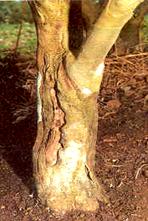
|
Collar canker (Phomopsis theae Petch), is also sometimes causing serious problem in low altitude gardens in Darjeeling. P. theae primarily affects clonal tea and its development is influenced by low soil moisture and the concomitant low bark moisture. The worst attacks found soon after prolonged drought. This is generally found to occur in the young clonal and replanted areas between two to eight yearsof age. Seedling tea is however rarely affected. Cankers are produced at the collar and on branches. An injury on the collar under such conditions offers ready avenue of entrace of the fungus. Chlorosis,cesation of growth and profuse flowering are the common symptoms of the disease. Application of fertilizer close to the collar, surface watering during dry weather, deep planting, pegging or bending and time of prune have a marked effect on the development of this disease. Collar pruning helps the plants to recover from the diseas. |
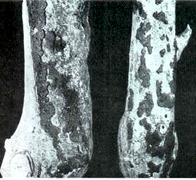 |
Wood rot caused by Hypoxylon serpens (Pers. ex Fr.) kick and the fungus is said to enter the stem through moribund
tissue following injury by sunscorch. Once the fungus gains entry into the stem it spreads gradually within the branches, ultimately reaching the main stem. Often only one branch or a portion of the bush which is affected by ‘wood rot’ dies; but when the infection girdles the main stem the entire bush is killed. Irregular, slightly raised, whitish-grey to dark patches (stromata) fructifications forms on the affected wood.
Control: Removal of dead and dying branches by rejuvenation pruning followed by painting of large pruning cuts with copper oxychloride can protect tea from this disease. Applicationof increased levels of potash to generate sound primary frame helped significantly in removing the disease. |
Stem canker (Macrophoma theicola Petch) disease is mostly prevalent in drought susceptible areas where soil is poor. The occurence of the disease is very rare in Darjeeling. In general, tea bush affected by sun-scorch is prone to this disease.The diseased patches on the branches appear as slightly sunken lesions surrounded by a ring of callus growth.The affected branches are killed
slowly by the invading fungus until the disease spread to the collar when upper portion of the plantdies. In mild infestations the cankers are callused over completely within a few months, but the fungus may renew its growth forming concentric cankers under adverse conditions. Fructifications are produced onthe dead bark during wet weather. Control: Affected branches should be cut out to clean healthy wood. Plants should be protected from sun-scorch and pruning during dry weather should be avoided. |
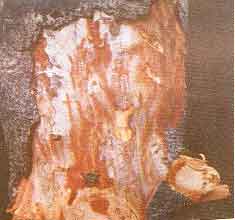
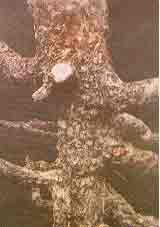
|
Root diseases
Charcoal stump rot caused by Ustulina zonata (Lev) Sacc. (= U deusta (Fr.) Petrak) is widespread root disease in the hills of Darjeeling. There are no visible symptoms on
the surface of the affected root but if the bark near the collar is removed characteristic delicate fan-shaped patches of dull white, silky mycelium may be seen spreading over the diseased wood. The fungus develops fructifications abundantly at the collar or on the main stem which are irregularly ovoid, thin and plate-like with concentric furrows. They are charcoal black and brittle when old. The spread of the disease is by root contact as well as by windborne spores. Sometimes it is seen that part of mature bush affected by this disease dies while other side remains apparently healthy and functional.
Brown root rot (Fomes noxius Corner) is commonly occurring in hills garden. Diseased roots are encrusted with earth and gravel and bound together by typical tawny brown mycelium. This crust can not easily be removed or washed off. When the infection on the roots is in advanced stage, the underside of the bark and the wood is marked by thin brown lines in a honey-comb pattern, known as reticulations. At this stage, the wood of the diseased root becomes soft, spongy and crumbling under slight pressure. Since infection spreads mostly through diseased root materials, dead tea bushes and stumps of the shade trees are potential sources of the disease.
Black
root rot (Rosellinia arcuata Petch) disease was found to be prominent in high altitude estates of Darjeeling. The disease is characterised by black wooly mycelial growth on the bark of the infected root and also
at the collar region, and presence of star-shaped patches of white mycelium on the wood. Infection spreads through spores as well as direct contact with diseased materials. The disease spreads rapidly in soil rich in organic debris. Control: Root diseases, unlike other diseases, are difficult to control and it is far too late by the time their presence is detected. When disease noticed immediate uprooting with all roots of the diseased bush (es) together with ring of apparently healthy bushes are to be done. When it involves into a large area, the diseased patches should be isolated by a trench of 45 cm wide and 100-120 cm deep all around until uprooting can be undertaken. Then the areas should be kept under thorough soil rehabilitation with Guatemala grass at least for two years before replanting or refilling. The plants should be watered with systemic fungicides at the time of planting and subsequently at three to four months intervals for a period of one year. Though isolation of diseased patches by digging trench produced desirable results, was comber-some and labour
intensive, demanding frequent inspection to keep the trench clean. Improving the conditions of the soil is an important step towards the control of root diseases. Removal of stumps left in the soil would certainly eleminate the food base of secondary root rot pathogens. The operation of ring-barking carried out before felling the tree (shade tree) will deplete the starch reserves in the stump, thus making it unsuitable for the root rot pathogen. The ring barking is a method of killing big trees or shade trees. It consists of removing a ring of bark, about 30 cm wide at a height of about 1 m from the ground. While removing the bark, the cambium is also removed exposing the wood. Some toxic chemicals like 2, 4, 5 T mixed with diesel or kerosene (10 percent solution) may be applied to the ring. Secondary root diseases may be tackled by alleviating the pre-disposing factors responsible for their incidence.Sometimes, the root of the cuttings when started growing, occasionally parasitised by the species of Pythium and Fusarium. They invade the tissues and the infected roots degenerate rapidly. Application of Mancozeb (Dithiocarbamates) or Captan (Phthalimides) @ 0.3 % (30 grams in 10 litres of water) is recommended. |
| |
| |
|
| |
|
|
|
|